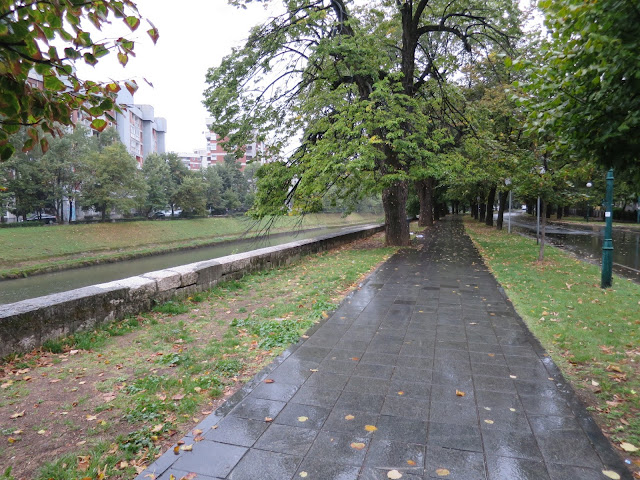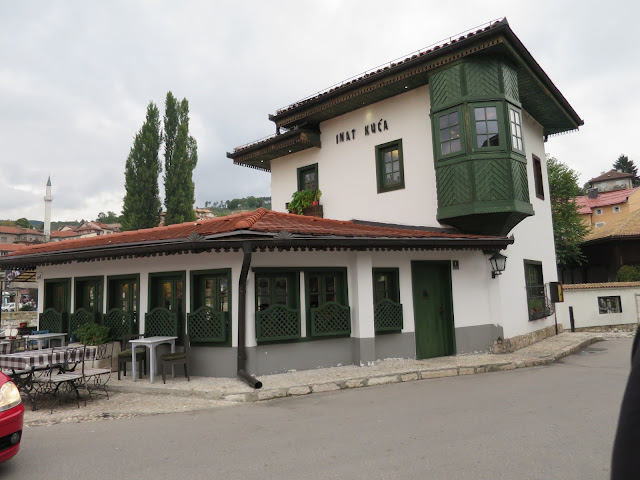We left Sarajevo with mixed feelings. It captured our hearts
with its sad history but also gave us the worst experience in our Balkans
travel. We shall not give you a history lesson on the 1992-96 Siege of Sarajevo;
it’s all readily available online with in-depth details. Best preparation you
can do before you visit this city is to read up on its rich history. It’ll help you to appreciate this city’s charm as you do your exploration. We signed up for a free walking tour which gave us a good base to understand Sarajevo. Then we followed Rick Steve's suggested walking trail which took us to other parts of the city. Follow us on this photo tour of Sarajevo:
A world-changing event that started from this spot. We were shown where
and how Austro-Hungarian archduke Franz Ferdinand was assassinated by Gavrilo
Princip in 1914. The place is marked by plaques and a small museum.
Inat kuća – House of Spite. Interesting bit of history. After Austro-Hungarian
defeated the Ottomans in 1878, there were plans to rebuild Sarajevo. On the
spot where the foreign architects wanted to build the City Hall was a house of
an old Bosnian named Bendevijia, who refused to give up his home. After many
negotiations he requested for a bag of gold and his house to be moved piece by piece to the other
side of the river. It’s a restaurant now offering traditional Bosnian food.
The afore-mentioned City Hall, which became the National and University
Library of Bosnia and Herzegovina in 1949. During the Siege of Sarajevo the
library was completely destroyed. Our heart twinged when we heard our tour guide
mentioned the loss of precious manuscripts and a unique collection of Bosnian serial
publications, some from the mid-19th century. Before the attack, the library
held 1.5 million volumes and over 155,000 rare books and manuscripts.
Baščaršija - Sarajevo's old bazaar. Lots of character. Do some souvenir shopping
on this pretty cobblestone street, full of small artisans' shops and touristy shops. Take your pick from among copper wares, shawls, trinkets and even pens made
of spent shells and bullets. We would love to get a bullet pen but we realized
we might get an eventful custom clearance in Singapore. You can enjoy some spots of
lunch at the small restaurants and drink delicious Bosnian coffee in cafes.
Sarajevo's only intact caravanserai, Morica Han. Reminded us
of Chinese period drama where travelers could find lodging, fodder for horses,
exchange money, do some business and repair their carts. Currently occupied by
restaurant, market stalls and offices which marred the exotic atmosphere considerably.
Group of elderly gentlemen playing a game of chess. Apparently, they are always there, no matter the weather conditions or time. They would have played out there during the siege if they could.
 Sarajevo
Roses which can be seen throughout the city. Explosion marks have been filled
with red resin to mark where mortar explosions resulted in one or more deaths.
They are disappearing as the asphalt is replaced or due to foot and car traffic.
Sarajevo
Roses which can be seen throughout the city. Explosion marks have been filled
with red resin to mark where mortar explosions resulted in one or more deaths.
They are disappearing as the asphalt is replaced or due to foot and car traffic. 
The
vaulted ceiling architectural details inside the bezistan which is worth an admire. The stalls sold
knock-off fashion apparels if you are interested.
Ruins of Taslihan, used to serve as caravanserai. Located in
Hotel Europa grounds near Gazi Husrev-bey bezistan. It was destroyed by fire
several times, the last time in 1879.
Marker on the ground, near Gazi Husrev Bey’s
Bezistan. “Sarajevo Meeting of Cultures” - with one step, you can cross
from one culture to another. The East is considered Ottoman and Islamic while
the West is seen as Austro-Hungarian and Christian.
Sarajevo’s main market. It was bombed during the siege when
the locals were busy doing their grocery shopping. Seasonal vegetables and fruits grown by sellers are sold here. We came late noon, so most of the stalls were closed. We
managed to get some corns for our dinner and our favourite snacks – walnut and
raspberries. It was a novelty for us to get them fresh and we gobbled lots of
raspberries, blueberries and strawberries whenever we see them in markets in
the Balkans.
Eternal flame, a memorial to the military and civilian victims of the
Second World War in Sarajevo. It is located in the center of Sarajevo at the
corner of the Marshal Tito street and Ferhadija
Pedestrian Street.
Memorial to children of Sarajevo. The monument consists of an
unfinished sand castle in the shape of a pyramid. It symbolizes the play of
children being cut short by death. The pyramid was partially made from spent
cartridges that were found in the city after the war. There’s several small
columns engraved with the names of 521 children who were killed during the
siege.
Painting on the ground in front of the memorial
Bosnian food which we bought from an “economic rice” stall. We
had high expectation but of course, it differ a lot in taste to our Singapore’s
version.
Suada and Olga Bridge, however the signage still indicates its old name
“Vrbanja Bridge”. New name is to commemorate Suada Dilberović and Olga Sučić, first
victims shot at the beginning of the Siege of Sarajevo. On 19 May 1993, Admira
Ismić and Boško Brkić, a Bosniak and a Bosnian Serb
were also shot while
trying to cross the bridge to escape the besieged city. They died in each other's arms and their bodies lay together for eight days as nobody was able to retrieve them safely. The bridge is nicknamed “Romeo
and Juliet” bridge.
 Turn right from "Romeo and Juliet" Bridge and amble along River Miljacka (Vilsonovo Ave which is pedestrians
only after 5pm and on weekends) with its path lined with trees which were not
fell for fuel during the siege as it was in the direct line of fire from the Bosnian
Serb snipers holding fort in the surrounding hill on the left.
Turn right from "Romeo and Juliet" Bridge and amble along River Miljacka (Vilsonovo Ave which is pedestrians
only after 5pm and on weekends) with its path lined with trees which were not
fell for fuel during the siege as it was in the direct line of fire from the Bosnian
Serb snipers holding fort in the surrounding hill on the left.
Apartments with scars of the siege.
 1-metre-high ICAR Canned Beef Monument to ridicule donors for the
humanitarian aid during the siege. Inscription reads "Monument to the International Community by the
grateful citizens of Sarajevo". Bosnians accused the international community of not allowing them to
defend themselves after imposing an arms embargo in the 1990s, and then feeding
them outdated canned food.
1-metre-high ICAR Canned Beef Monument to ridicule donors for the
humanitarian aid during the siege. Inscription reads "Monument to the International Community by the
grateful citizens of Sarajevo". Bosnians accused the international community of not allowing them to
defend themselves after imposing an arms embargo in the 1990s, and then feeding
them outdated canned food.
Why not cash in on war? Café Tito serves drinks only and
attracts tourists interested in memorabilia from old Socialist Yugoslavia. There
were tanks outside the café which makes for great photo.
A stone block with the text carved in four languages: “Under
this stone there is a monument to the victims of the war and the Cold War.” By
Bosnian artist Braco Dimitrijevic.
We enjoyed Sarajevo and had a memorable time due to our horrible
experience with rancid flat bread and the rickety place we stayed in. We left
with regrets that we did not managed to delve deeper into Sarajevo. It’s a city
still full of sadness as the bullets scars were conspicuous on lots of
residential buildings. Bombed buildings were also left abandoned. BiH (Bosnia and Herzegovina)
has the world's most complicated and strained system of government. The Chair
of the Presidency rotates amongst three members (a
Bosniak, a Serb, and a Croat) every 8 months within their 4-year term. With conflicting
views on a large number of issues and problems, it’s impossible to
rebuild the country. Unemployment is an unimaginably high 43.9% in 2014. We can’t
see the light at the end of the long dark tunnel for BiH. It’s
heartbreakingly sad. The people are trying their best to make ends meet. They
rent out their homes to tourists and became tour guides earning tips. We can
only hope our visit have help someone in one way or another as we sleep in
their home and took up their tour.

























No comments:
Post a Comment